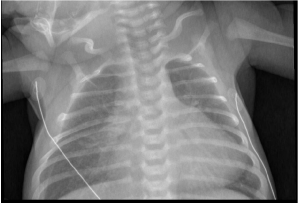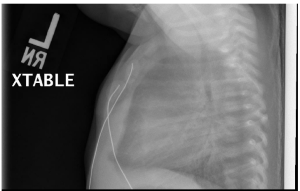Hot Seat #47: 2 week old F w/ tachypnea and retractions
Posted on: November 11, 2014, by : Kaynan Doctor
by Kaynan Doctor, Children’s National
with Desiree Seevaye, Children’s National
The Case
2 week old female presenting with her mother for tachypnea and retractions. Mom reports that for the past 4 days she has been increasingly more congested and has been grunting when sleeping. In the last 2 days there has been intermittent choking with feeds and on the night of arrival the patient had an episode of NBNB projectile vomiting that was associated with peri-oral cyanosis. She has surpassed her birth weight.
ROS: Breast fed infant, feeds for 15 minutes, no fevers, no jaundice, rash, bruises or petechiae, no conjuctival injection or discharge, 4 normal stools daily, 4 -6 wet diapers daily.
Birth Hx and PMHx: Induced VD at 39 weeks due to maternal preeclampsia and PRES (Posterior Reversible Encephalopathy Syndrome). No maternal fevers, prenatal labs including GBS screening non-concerning. No medications taken prior to or during pregnancy apart from multivitamins. Patient was admitted to newborn nursery while Mom was recovering in ICU and went home with Mom.
PE: Vitals: T 37.0 HR 160 RR 80 BP 94/41
Gen: Sleeping in Mom’s arms
Skin: Central cap refill at 2 seconds. Acrocyanosis of the extremities
Head: Normocephalic. Anterior fontanelle soft and flat.
EENT: MMM strong suck, but gags with sucking.
Cardiovascular: Regular rate and rhythm. No obvious murmurs, S1 S2, no brachio-femoral delay.
Respiratory: Subcostal and intercostal retractions and on numerous occasions noted to have marked tachypnea No crackles. No wheezes. Transmitted upper respiratory sounds
Gastrointestinal: Soft. Liver edge at 3cm .
Neurological: Normal Newborn reflexes but some head lag on picking up with hands. Moro present
A physician-lead triage is being trialed and a CXR was ordered based on the chief complaint and vital signs.
Questions for you:
Other <3 yrs: review CXR w/ rads, ribs on right? EKG.
Other >3 yrs: ECG, vbg, cards for echo. skeletal survey. cardiology consult and echo. O2 sat, radiology reading of CXR for c/f right sided rib fractures.
Interim Update:
You decide to obtain IV access and the following labs return:
WCC 8.81, Hb 14.2 Hct 39.5 Plt 395
Na 144, K 4.1, Cl 106 CO2 24 BUN 11 Cr 0.8 Glu 86 Mg 2.0 Ca 9.2
Other >3yrs: ECHO. head CT.
How would you approach this case? Please share your opinions by clicking on “What do you think?” below.



What’s the O2 Sat?
The CXR demonstrates abnormaility in the ribs on the right concerning for fractures, which would raise the suspicion for NAT. Were there any other signs of trauma on the physical exam?
Shortness of breath is typically respiratory or cardiac in etiology. However, this child does not exibit and URI symptoms or adventitious breath sounds or have significant air-space disease on CXR. It would be nice to know the O2 sat to reassure that there is no problem with oxygenation in the lungs. Cardiac causes include congestive heart failure from either overcirculation or obstructive cardiac lesions, but the heart shadow is only upper limits of normal and there is no murmur. I presume this kid will get an EKG and echo as they are non-invasive and easy to obtain, along with 4-extremity BPs and O2 sats pre-post ductal. If neither pulmonary nor cardiac causes pan out, then consider severe metabolic acidosis (but this child had normal HCO3) or hematologic (severe anemia-but child with normal H/H; or methemoglobinemia-well water?), or pain (from rib fractures???). In a 2 week-old, neurologic causes such as periodic breathing or head bleed (but this child had head was NC and AFOFS) should also be considered.
I’d really like to get a radiologist’s opinion of those right sided ribs and consider additional imaging to evaluate for NAT.
A lot of the time we see NAT in babies, there is a callous in the rib area. but there isn’t one here…implying this is fresh. this makes me worry more about other injuries like liver lacs and intracranial things. that rib abnormality doesn’t look congenital, like a hemi-vertebrae associated with a genetic syndrome. If it’s acute and there’s not a hemothorax, then the kid is either breathing fast for pain or because there’s something in the head……so it’s really NAT until proven otherwise.
I love Dewesh’s great differential– it’s really important to keep an open mind when evaluating a tachypneic infant, especially in the winter season when we are often quick to assume a respiratory infection as the etiology. Another thought that came into mind as I read the case was an H-type TEF, certainly much more rare but something to consider with the history of recurrent feeding-related choking/cyanosis. But after seeing the CXR, I agree that LFTs and a radiology consult would be my next step..
Nazreen! Thanks for the comment 🙂
Hello Nazreen!
Just lost my comment so will retype.
My initial approach, of many possible approaches, is to think of tachypnea with and without retractions. With retractions, the focus is much more on a pulmonary etiology. The most common in this age would be bronchiolitis and pneumonia. With the choking with feeds, I think of TEFs, with the rarer types (H) being diagnosed after discharge. But the exam and the CXR don’t support these diagnoses. As pointed out above, rib fractures cause tachypnea related to pain (+/- retractions) or related to underlying pulmonary injury (+retractions). I find acute rib fractures particularly difficult to see. I would speak to the Radiologist about this question specifically because of how sick the baby is. Consider dedicated rib films (ribs are flattened out to better view lateral portion).
With tachypnea without retractions, the differential broadens to include acidosis from metabolic disease, profound dehydration, brain injury/NAT, and sepsis.
In retyping I left out the cardiac causes of tachypnea…. acyanotic lesions leading to pulmonary overflow, such as large VSD, PDA, AV canal. The CXR shows a normal cardiac size (in my read) with no specific shape denoting a cardiac lesion. The lungs also don’t look wet. Given the normal cardiac exam, a cardiac cause of the tachypnea would not be my first thought, but agree with the work-up recommended above.
This neonate is having worrisome episodes of choking with feeds with projectile vomiting associated with peri-oral cyanosis. This is more worrisome to me than the usual presentation of “ALTEs” with choking but no cyanosis. He is also markedly tachypneic with retractions. I would also like to know if there was any apnea and if the episode of cyanosis self-resolved or if the baby needed stimulation for resolution.
I would go through a systems approach to this patient:
1. Anatomic: anomalies of the upper airways eg.
a. – Choanal atresia may present like this, with worsening due to URI. This could be diagnosed simply by passing a suction tube through both nares.
b. Laryngotracheomalacia – can cause resp distress that worsens with URIs, however there is no mention of stridor or loud breathing.
c. A right aortic arch or double aorta can cause compression of both the trachea and esophagus and give rise to both difficulty with feeds/emesis and respiratory problems. The CXR in this case does not show a normal looking aortic arch, however the baby is slightly rotated to the left hence limiting the usefulness of the xray.
d. TEF-H type can present similarly with respiratory and GI problems.
2. Respiratory causes:
a. nasal congestion in the newborn who is an obligate nasal breather, can cause mild retractions and tachypnea, however should resolve with suctioning, and usually does not cause emesis to the extent of peri-oral cyanosis.
b. Pertussis comes to mind with post-tussive emesis and cyanosis, but the symptoms are only 4 days long and pertussis is usually a longer course than this.
c. NAT: The ribs on the CXR on the right (5th and 6th ) are closer together and appear abnormal – I don’t see any acute fractures, and perhaps there is a callus below rib 6 – I would talk to radiology about this.
3. Cardiac:
a. Congenital heart defets: the apex of the heart looks raised giving the appearance of a boot, however the infant does not have any other features of TOF such as low O2 sats, or heart murmur.
4. GI: GI causes are the most common reasons for ALTEs, especially reflux, but does not usually also cause respiratory problems unless there is concommitant aspiration pneumonia. I don’t see any consolidation on the CXR, but radiologic findings can lag behind clinical findings by hours-days.
As others have mentioned above, work up for NAT if radiology agrees with findings of rib fracture/callus, metabolic causes, sepsis are lower down on my differential. I would do a partial sepsis workup only because of the age of the baby.
Other work up can be done in the ED, such as pass suction catheter through both nares, suction nares, EKG and ECHO. I think this infant should be admitted as he is only 2 weeks old. In general I admit babies who are younger and those that have scarier events like apnea and/or requiring CPR, and high parental anxiety. If there were episodes of apnea or needing stimulation, I would admit to NICU/PICU.